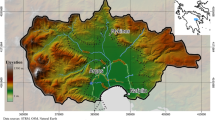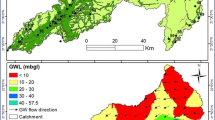Abstract
Groundwater is a key resource for agriculture, which uses approximately 9–105 Mm3 of groundwater in producing a global output valued at $210–$230 billion each year (Shah et al. Water for food, water for life: a comprehensive assessment of water management in agriculture. Earthscan and Colombo, International Water Management Institute, London, 2007). The analysis of groundwater abstraction and water levels shows that the area's excessive water abstraction almost fully controls the aquifer's hydrology. The hydro-abstraction well is a hydraulic structure which is used as an alternative source instead of Ranney well. The problems with Ranney wells are that Ranney wells are difficult and need a complex hydro-geological system where the sub-surface strata should be medium-to-coarse sand along with water table condition within 6 m from the ground surface. If the clay layers come in between, depth of the Ranney well which is 32 m, then sinking of Ranney well cannot be done uniformly. As a result, the rings/walls of the Ranney well develop cracks and fail due to differential settlement where the RCC of the rings comes under tensile position. Irrespective of Ranney well, the hydro-abstraction well can be installed anywhere along the river bank with all types of strata and to a depth of 15 m water level from the ground surface. To address the seepage and ground water issues and manage them, the paper compares the two types of wells. The investigation that was done on a location that is often influenced by ground water hazards is described in the report. For the interpretation of the sub-surface geological feature, fieldwork justifications are given.












Similar content being viewed by others
References
Aghazadeh N, Mogaddam AA (2002) Assessment of groundwater quality and its suitability for drinking and agricultural uses in the Oshnavieh area, Northwest of Iran. J Environ Prot 1:30–40
Barthak, Grischak (2018) Groundwater Abstraction through Siphon Wells-Hydraulic design and energy savings
Chapman D (1996) Water quality assessments-a guide to use of biota, sediments and water in environmental monitoring, 2nd edn. University Press, Cambridge (0419205905 (HB) 0419216006 (PB))
Ground Water Year Book (2019–2020) National Capital territory, New Delhi, 2019–2020, Central Ground Water Board, Ministry of Jal Shakti
Hermides D, Kyriazis D, Makri P, Ermidou A (2020) Geochemical evolution of the Thriassion plain groundwaters, Attica Greece. Environ Monit Assess 192:561. https://doi.org/10.1007/s10661-020-08491-z
ICMR (1975) Manual of standards of quality for drinking water. Indian Council of Medical Research, New Delhi
Lloyd JW, Heathcote JA (1985) Natural inorganic hydrochemistry in relation to groundwater. Clarendon press, Oxford, p 296
Milovanovic M (2007) Water quality assessment and determination of pollution sources along the Axios/Vardar River, Southeast Europe. Desalination 213:159–173
Saleem M, Ahmed M, Mahmood G (2022) Analysis of groundwater quality improvement using rainwater harvesting: a case study of Jamia Millia Islamia. Int J Modern Eng Res (IJMER)
Shah T, Burke J, Villholth K (2007) Groundwater: a global assessment of scale and significance. Water for food, water for life: a comprehensive assessment of water management in agriculture. Earthscan and Colombo. International Water Management Institute, London
Shiklomanov IA, Rodda JC (Eds) (2003) World water resources at the beginning of the 21st centuary. Int Hydrol Ser 435. Cambridge University Press, Cambridge
Sreedevi PD (2002) Groundwater quality of Pageru river basin, Cuddapah district, Andhra Pradesh. J Geol Sci India 64:619–636
Funding
The paper is supported by no funding.
Author information
Authors and Affiliations
Corresponding author
Ethics declarations
Conflict of interest
The authors declare no conflicts of interest.
Additional information
Publisher's Note
Springer Nature remains neutral with regard to jurisdictional claims in published maps and institutional affiliations.
Rights and permissions
Springer Nature or its licensor (e.g. a society or other partner) holds exclusive rights to this article under a publishing agreement with the author(s) or other rightsholder(s); author self-archiving of the accepted manuscript version of this article is solely governed by the terms of such publishing agreement and applicable law.
About this article
Cite this article
Ul Hassan, O., Jafar, Z. & Mehmood, G. Comparative study of Ranney well and Hydro-abstraction well and ground water quality analysis: a case study of Jamia Milia Islamia, New Delhi. Model. Earth Syst. Environ. 9, 3243–3251 (2023). https://doi.org/10.1007/s40808-022-01673-3
Received:
Accepted:
Published:
Issue Date:
DOI: https://doi.org/10.1007/s40808-022-01673-3




